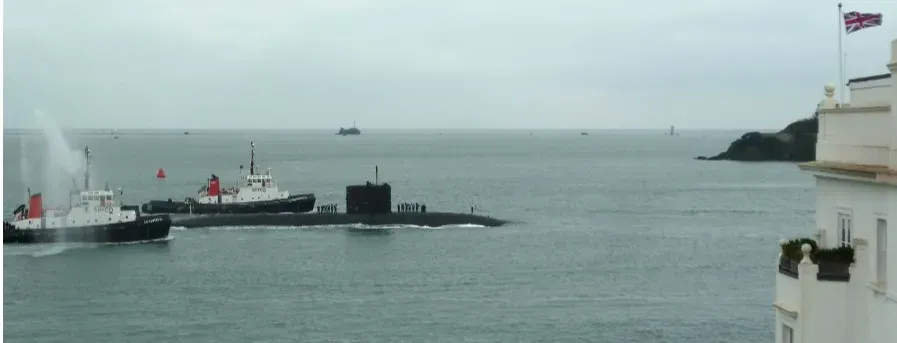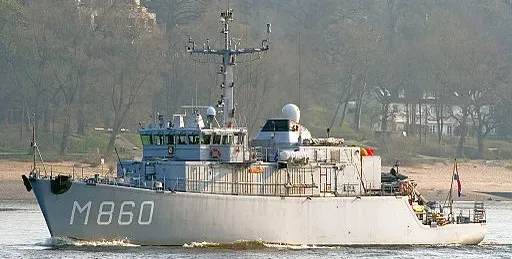Nuclear sign-off: On board HMS Triumph - the last of the T Boat submarines

The Captain - Beagle maritime correspondent - goes on board to witness the end of an era in Devonport
I was lucky enough to spend a couple of hours onboard HMS Triumph, the last of the Royal Navy’s Trafalgar class or ‘T Boat’ submarines.
When I first wrote about her on 12th December, I observed that submarines are traditionally ‘boats’, not ships. Perhaps because ‘ships’ carry boats, but submarines don’t. However, I now understand that the submariners’ preferred version is that the first submersibles were no more than diving bells carried on ships and, as such, were listed as ships’ ‘boats’.
As submersibles developed into today’s major warships, the name stuck and ‘boats’ they are, and no doubt, will remain.
One of the reasons I had asked to visit HMS Triumph was to see and understand how a ship’s life ends. [1] Before HMS Triumph returned to Devonport, she had unloaded her main armament – Tomahawk land attack missiles & Spearfish heavy torpedoes to the Armament depots in Gibraltar and Faslane. Her waterline is already over 30cm lower than it was when she was fully operational.
Almost as soon as she arrived home, over half her ship’s company left – initially on leave and then to professional courses for future posts in the Navy. In consequence, many of the onboard facilities, such as the galley, have already been shut down and the crew are now fed from a shoreside galley. Similarly, she is now connected to the dockyard firemain.
As the last of her class, there was no queue of people from other submarines wanting to remove pieces of equipment as spares, but this has usually been the case when other submarines have left service. This, of course, does not just apply to submarines. Many locally will remember HMS Eagle sitting at her buoys in the Hamoaze from 1972-78, where she acted as the source of spares for HMS Ark Royal.
Any warship contains a mass of stores – from food and bedding to spare parts for the equipment onboard. Some of this will be classified and so must be fully accounted for and signed over to another custodian. The classified documentation, which runs to over 2000 items in Triumph’s case, will all be individually numbered and, in the case of paper books (there still are some) every page has to be checked before they are handed over to the Naval Base’s confidential bookstore.
As well as the more obvious stores and spares, every ship & boat in the Royal Navy has some pieces of silver that have been donated to her, and her previous namesakes, over the years. These will all be returned to the Trophy Store in Portsmouth, ready to be issued to the next HMS Triumph, or to another ship that (usually) has a connection and wishes to hold them. As an example, I know that the Royal Navy’s Advisor in the British High Commission in Islamabad borrowed several items from the Type 21 frigates, that are presently serving their second life in the Pakistan Navy.

Despite many of the boat’s essential services now being provided from ashore, whilst the reactor remains capable of producing power, her engineering team remain onboard and continues to monitor it around the clock. Once the reactor has been ‘poisoned’, so that it can never be used again, the boat will be handled to Babcock and will join her six sisters, and the seven other decommissioned nuclear submarines (SSNs[3]), awaiting disposal in Devonport’s 3 Basin.
There are presently 13 decommissioned nuclear submarines in 3 Basin, and they will be joined by Triumph (no longer HMS once she decommissions) in 4-5 months. All nuclear material has a half-life, which varies from nanoseconds to billions of years. It is calculated that old nuclear submarines need to ‘rest’ for 30-35 years before the risk of dismantling them is acceptable. ‘Once upon a time’, the plan was to fill old nuclear submarines with concrete and sink them in the region of the North Atlantic Ridge which “exhibits naturally elevated levels of radioactivity due to the presence of uranium and thorium isotopes within the volcanic rocks that form the ridge”[4].
However, this plan became untenable as the environmental risks became clearer and was no longer ‘legal[5]’ after the UK signed the London Dumping Convention in 1973. The first programme to dispose of the RN’s old SSNs is already underway in Rosyth and will, no doubt, be duplicated in Devonport once the process is proved to be completely safe.
I should like to thank Commander Aaron Williams and his men (yes, all men. Triumph is the last RN submarine not to have women in her crew) for their hospitality and for both answering my numerous questions and for listening to too many, probably, of my ‘dits’ about how it used to be! I found the esprit de corps onboard to be high – despite their admission about how depressing it is to run down a fully functioning warship that you have just spent a couple of years of your life looking after.
As the last of her generation, Triumph’s last year, or so, has obviously been a bit fraught at times – rather akin to owning an old car I suspect. But, from everyone I spoke with onboard, it was clear that they had a real affection for her. I wish them all the very best as they move on in their careers, many to the new A-class SSNs.
[1] Yes I know! But ‘warboats’ doesn’t sound right & the processes apply to both ships & boats.
[2] The first generation SSBNs (the Resolution class) and three old SSNs are kept in Rosyth dockyard. The Scottish Government has banned any further storage of old SSNs in Rosyth.
[3] SSN, in NATO speak = SS for submarine & N for nuclear. Conventional submarines are SSKs, as SSCs are coastal submarines. Deterrent submarines are SSBNs – with the B indicating that they carry Ballistic missiles.
[4] Quote from the web.
[5] I say ‘legal’ because International Law is – ultimately – only what Nations are prepared to be bound by and, in extremis, …….



